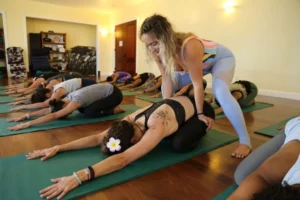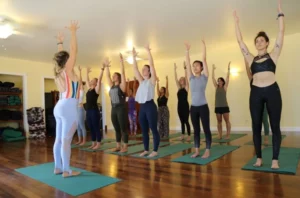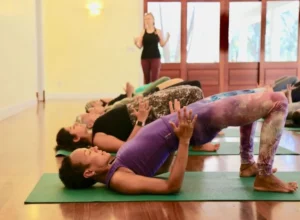Allow me for a moment to lead you on a journey through the benefits of yoga for stress and anxiety relief…It’s evening time and you enter a yoga class room. You’ve had a long and wearying day and you’re exhausted from the stress and anxiety of daily life. Your mind is still full of all the little things and tasks from your day and you just want to do something good for yourself. But once in the class room you start asking yourself why you didn’t just stay home on the couch to watch the next episode of your favorite Netflix show. All the same, you’re already here, so you might as well go ahead and get moving.
You take a deep breath…
The class starts slowly, pulling your attention away from your busy day, away from the voice in your head that keeps reminding you of all the little things that happened today and of all the tasks that lie ahead. The teacher draws your attention to your breath and to the sensations of your body on your yoga mat. Gradually the pace of the class picks up and you start feeling new energy flowing through your body, revitalizing you both mentally and physically. After an hour of moving through various asanas and focusing on your breath and movements, you forget all about the mind state you entered the class with; you feel refreshed and energized, and at the same time calm and grounded.
Does this experience of stress and anxiety relief sound familiar?
Well, you are not alone! What you are feeling are the benefits of yoga for stress and anxiety reduction.

The science behind the benefits of yoga for stress and anxiety reduction.
So what causes these changes in our body and mind which allow us to experience the benefits of yoga for stress and anxiety? How are the asanas in yoga different to the movement in other forms of exercise? After all, running or playing tennis are also associated with many health benefits. But these activities usually aren’t accompanied by the same sense of well-being as yoga. It seems that the focus of yoga on improving through both physical and mental practices incorporates more mindful elements that are absent in traditional forms of exercise. Indeed it is this mindfulness might make the difference between just going for a run and practicing yoga.
But yoga for stress and anxiety reduction goes a bit further than this.
Firstly, in the recent years, scientific research on yoga and its effects on well-being, stress reduction, anxiety relief and many other aspects of health has seen an exponential rise (1). This means that the large gap between western scientific evidence for the benefits of yoga and the claims of the ancient yogic scriptures – where yoga is described as a pathway to inner well-being – is slowly becoming smaller.
Mind- Body Approach to Stress and Anxiety Relief
Yoga seems to affect the physiology of our mind and body in different ways. One review, for example, showed that yogic breathing helps to shift the body’s alertness from a sympathetic state to a parasympathetic state, meaning our bodies and minds enter a state of relaxation (2, 3). Additionally, two other reviews showed that yoga practice could help to relieve symptoms of stress and anxiety in many different populations, ranging from healthy adults over student populations, people with depression and anxiety disorders to cancer patients (4, 5). So how does this shift from the sympathetic to the parasympathetic system occur?

It’s all in the chemistry!
Our bodily functions – and with that our mind and mood – are all governed by hormones and neurotransmitters that help to keep each subsystem on track so that it will function the way it is supposed to. However, sometimes these (sub)systems derail and all hell breaks loose. Okay, that’s a little over-dramatic but you get the point.
Yoga’s Affects on GABA levels
For example, it has been shown that certain hormones and neurotransmitters are dysregulated (there is too much or too little of them) in people with depression or anxiety disorders (6). One of these little regulating friends is GABA. This neurotransmitter is an important inhibitory neurotransmitter that serves to regulate anxiety, stress and fear. If GABA levels are too low, there is no more selection of which messages are sent from the nerve cells to the brain and we become easily overstimulated by our surroundings and thoughts (6).
It’s not just the exercise
Multiple studies have looked into the effect of yoga on GABA levels. One study, for example, compared the effects of a 12-week intervention including either walking or yoga (3 times a week) on the participants’ mood, anxiety and GABA levels (7). After the intervention period, the researchers found increased GABA levels and improvements in mood and anxiety scales in the yoga group but not in the walking group.

An Hour is All it Takes
Another study found a 27% increase in brain GABA levels following 60min of yoga compared to baseline (before the yoga session), while no difference in the control group (the group that didn’t do yoga) was found. Two other studies even found that a 12-week yoga intervention brought GABA levels in patients with major depressive disorder to the same level as in non-depressed individuals (8, 9).
GABA as a Regulator
This regulating property of yoga on GABA levels is also connected to the shift from sympathetic to parasympathetic activity, but diving further into this relationship is enough material for a blog post on its own (but have a look at this mini-review (10) if you’d like to know more about it). It is not completely clear yet how all the underlying mechanisms work together, but what we can say for sure is that yoga can lead to actual – positive! – changes in our physiology and it can help us to feel better.
In Conclusion
What makes these findings particularly exciting is that they suggest that yoga practice can improve multiple areas of our life at once. Let’s go back to our yoga class from the beginning of this post. You’re lying in savasana, relaxed, calm but at the same time energized and happy. Your GABA levels are probably quite a bit higher than when you started with the practice. You can now focus on the tasks ahead, thanks to the benefits of yoga for stress and anxiety. And you will probably remember this feeling and return to call or the mat. You are (hopefully) at the beginning of a positive feedback loop that will keep you more balanced, make you feel better physically and mentally and, possibly, provide you the energy to adopt healthier daily habits. It’s a win-win-win!
What to Read Next:
If you have enjoyed this article, check out MINDFULNESS MEDITATION: A TRAINABLE WAY OF BEING FREE